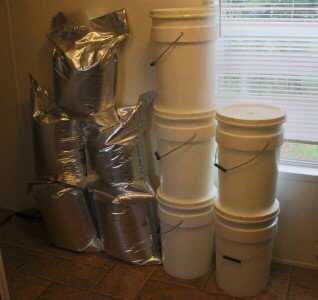
On the right are my 6 gallon buckets that I suggested in my first installment on food storage. By the pallet they are like 6 bucks each. The 20 x 30 Mylar bags next to them are about $1.50 each, and they hold more. As you can see, they don’t stack as well though.
Mylar 20 x 30 Food Storage Bags:
Uline $155/100
Amazon $62.99/50
Ebay Seller $139/100
Oxygen Absorbers:
Oxy-Sorb 2000cc O2 Absorbers – Amazon $18.98/30
Ebay Seller Bulk Sales (also dessicant)
12″ Impulse Heat Sealer $29.97 Ebay
When I first started this column, I discussed the importance of putting away your own bulk food, and not just buying a cat litter bucket with a “30 day supply” in it. Without food, water and shelter you will have to leave the house after things collapse, and that’s bad. You don’t have to spend big bucks on mail order food. Survival food is just food that won’t spoil without refrigeration. Beyond that, survival food is what you make of it. And you can make it a lot cheaper than you might think.
A $40 bag of pinto beans that weighs 50 lbs. has roughly 50,000 calories in it. Compare that to a $150 or more “30 day supply” from one of these survival food companies. That was the subject of the first article, and I gave you some great ideas and links that I hope at least some of you followed. The one thing I didn’t address in that article was the prospect of using Mylar bags, rather than buckets, and I recently decided to try them. Bags are much cheaper than buckets, but they just aren’t as robust. I’ll go over the numbers and details for you, and I sincerely hope that everyone who hasn’t taken action to provision for at least a few months of no food or water begin to do that now.
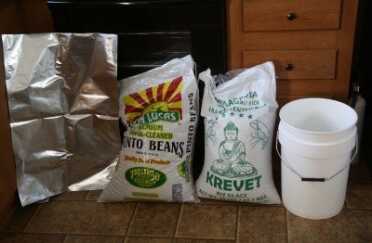
I found that while my 6 gallon buckets hold 40 lbs of rice or beans, a 50 lb. bag of either fits easily.
And just to clarify my position, I do have some prepackaged “meal” type supplies. When the SHTF, I don’t want to deal with meal planning. Like you, I’ll be scared and scattered, wondering what is happening next, and I plan to use those heater bags that I reviewed and some prepackaged food. Within a couple weeks (if we haven’t collapsed), I hope to get into details about the benefits of packaged foods, both from the survival suppliers and some survival food you will find on the shelf at Walmart. If you have some time yourself, I would go check out the canned food isle, and look at the caloric value of things like beef stew, (Mylar) packaged soup mixes, and even Velveeta, which is in the same isle.
For this article I want to focus on Mylar bags, because I already covered buckets, including a cheap source of 6 gallon buckets. If you don’t know what Mylar food storage bags are, you have eaten food out of them for years. Mylar these days is being used in place of cans for everything from tuna (usually in that same Walmart isle) to potato chips. There is no mystery to Mylar. It has a metal layer embedded between the plastic, and that metal blocks air, light and liquid, which makes it different from regular plastic.
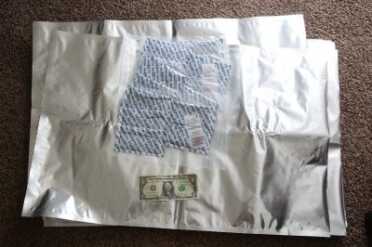
This is the size of the 20 x 30 bag, with some oxygen absorbers I got in a package from a seller on Ebay.
Mylar comes in different thicknesses, depending on the purpose and size of the bag. At some point I am going to get to “canning” using a very thick Mylar bag, but here we are talking about dry bulk food storage. The bags I purchased are apparently 4.4 mils thick, though the only site that seems to say that is Uline. This bag is 20 x 30 inches, and it is sold as both a 5 gallon and 6 gallon. The Ebay sellers seem to call them 5 gallon, because they advocate putting them inside 5 gallon buckets, apparently unaware that you can get 6 gallon buckets for the same price or cheap. And you don’t need Mylar bags inside of buckets. Modern plastic buckets are made of food grade high density poly, or HDPE, and the plastic is the most stable you can get.
Packages of 100 20 x 30 Mylar bags from Uline are $155, but I also found a deal on Amazon for 50 bags for $62.99. If you want fewer than that, or even more than that there are a number of people on Ebay selling 5, 10, and 20 packs with oxygen absorber packets for slightly higher overall cost, and even a few that sell them cheaper, as little as $100 per 100, in bulk.
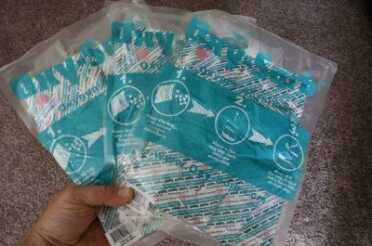
These are the oxygen absorbers I have been buying on Amazon in packs of 30. You have to get 10 buckets ready, then open the 10 pack that is vacuum packed, unless you have a Foodsaver and you want to re-close it.
You will also need at the very least oxygen absorbers, which I covered somewhat in the last food article. For these large 20 x 30 bags, the minimum I would use is the 2000cc oxygen absorber packets. If you go by 6 gallons as a volume, the actual cubic centimeters in the bag are well over 20,000, so if you figure that 10% of that space will be taken up by air when you pack loose material like beans and rice, and oxygen is roughly 21% of the atmosphere, 2000cc is well within the range of “just fine.” I have had both 6 gallon plastic buckets and these large Mylar bags suck in and look like they were vacuum packed, but you don’t need that. Nitrogen, carbon dioxide, and the other gas found in air are inert and won’t react with your food. Oxygen is the gas that destroys survival foods, and even plastic packaging. When you see “survival food” in Mylar, or even soups and other dry foods at regular supermarkets in Mylar, they don’t use use oxygen absorbers generally, because the packaging equipment is run inside a nitrogen pure environment, and no oxygen is allowed into the bags in the first place.
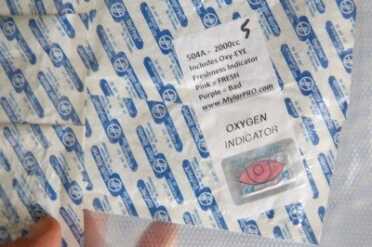
This seller is repackaging 5 packs of 2000cc absorbers and putting in a freshness checker, but there is no telling how long they had the absorbers out of the vacuum when they repackaged them. The manufacturers send them in 10 packs.
I buy my 2000cc absorbers from Amazon under the Oxy-Sorb name, $18.98 for 30 of them. The only thing is, they come in packs of 10 in a Foodsaver vac bag, so if you don’t have a Foodsaver to reclose the bag, get 10 buckets or bags ready, then close them all up at once. Oxygen absorbers go pretty crazy in open air and will be dead within hours. From what I have read, all of the large manufacturers of these absorbers ship in 10 packs for the 2000cc, so if you see a seller on Ebay selling 5 packs, that means that they opened them and repackaged them with a fresh “freshness tester” tab. See the pictures.
You will also need an electric heat sealer, unless you get the slightly more expensive zipper seal bags from that guy on Ebay. I prefer the heat sealer, because I have never met a zip lock that didn’t eventually fail. The sealer you need is called an impulse sealer, and the 12″ version comes with extra elements and teflon strips for under $30 on Ebay. These machines don’t have to wait to heat up. You just fill your bag, drop in your oxygen absorber, then press one side of the bag then the other. They don’t make a 20″ version, so the 12″ is the best bet for these big bags.
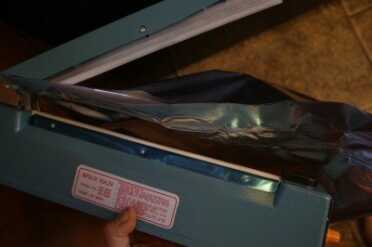
This is the 12″ impulse sealer that you can get on Ebay for under $30 with extra heating elements and teflon. Since the bag is 20″ wide you have to do it from both sides overlapping, and it works great.
And yes, the bags are big, much bigger than a 6 gallon bucket and for a lot less money. I actually bought a pallet of those 6 gallon buckets from that guy on Ebay that I linked to in the first article, and that brought the cost down to about $6 a bucket, so I am used to putting 40 lbs. of beans into a bucket. The bags take 50 lbs. of beans or rice easily, with plenty of room to close the bags, and I think you could get at least another 10 lbs. in there if you wanted to fill them as full as you can. It was the same for nonfat dried milk. I was able to get 5 of those 4 lb. boxes from Walmart into one bag, and I could have gotten at least one more but I hadn’t bought one more for my test so I just closed the bag. The same was true for pasta and if you plan to do a first run of 10 bags (to match the pack of oxy absorbers), I would get extra to see how much you can get in.
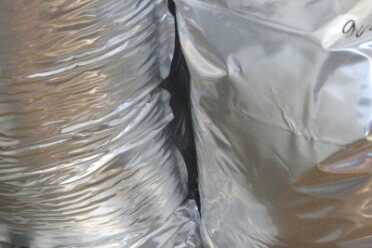
Sometimes you’ll find that the absorbers suck in the bag, sometimes not. It depends on the contents. 2000ccs is way more than how much O2 is in a 20,000 cc bag with stuff in it. O2 is only 21% of the atmosphere.
Stacking these Mylar bags is a whole other story. They don’t stack well, plain and simple, so if you are going to designate a room to food storage, you will probably have to make (Illuminati) pyramids with the bags, then fill in between the peaks for what will be a disorganized mess, but a ton of food in the available space. I didn’t try this idea, because I still have buckets to fill and they stack great.
Other than the stacking though, I can’t say that I know of a reason to prefer buckets over bags. Rodents can chew and do chew right through HDPE buckets if they are vulnerable to that. The bags don’t seem to be more or less water/air tight, and I can’t say whether ten years from now thee Mylar will crumble, but my guess is no. At $1.50 or less each, I don’t see a downside to choosing Mylar bags over much more expensive buckets. My only other comment is to maybe keep some plastic tubs with lids on hand to dump the bags into as you need to open them. Bags don’t re-close easily, and they are somewhat unwieldly.

Heavy HDPE bucket certainly feel more robust than Mylar bags, and they stack well, but on a budget… First get the food!! Then worry about the bags.
I can’t stress the importance of storing your own food, and making sure that you have access to water that doesn’t require an electricity source. It is such a mistake to think that as long as you have guns you can get anything else you need. Your neighbors don’t have any backup food either. Nobody does, and if you don’t either, don’t waste your time with “30 day supplies” from these food storage companies whose advertisements have so invaded our space. Take $500, even on a credit card, and go to Walmart. Buy cans of stews. Buy Walmart’s brand of Velveeta cheese, and canned tuna, turkey, SPAM, as well as dried beans, rice, flour, pasta, dried milk, soup mixes, drink mixes, oatmeal, cereal, and whatever else you know is going to last 10 years or more, not that you’ll store enough to last that long. Hopefully we are going to pull out of this, but the time looks to be growing short now on several fronts. Don’t leave yourself hanging out there with a stubborn assumption that everything is going to be fine. Most likely it isn’t.

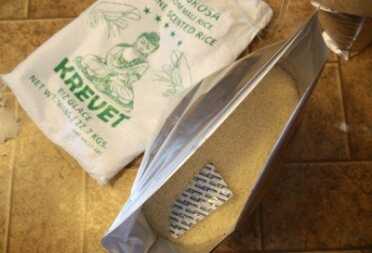
I would like to purchase Vacuum Sealer with Nozzle,in your store/company i would be happy if you can get back to me again with the prices and dimensions you having available in a moment,and also do you take all types of Credit Cards as your payment required?Kindly get back to me here so that we will work together as one panther. All the best and stay blessed.
Our Recommendation For the Oxygen absorbers, desiccants, and mylar bags, you may type in Sorbent Systems in California, in your search engine and go to their web site, they have excellent products, We’ve used them for years and they ship directly to you! For food grade buckets, barrels, and other containers check out Baytec Containers Texas.
I have found the best way to store food in the freezer is using a vacuum sealer. I think the food stays fresh a lot longer and doesn’t get the freezer burn taste as fast. It is good to know that when storing broccoli, brussel sprouts and cauliflower to blanch them before so the bad doesn’t expand. I will keep that in mind the next time I’m
Maybe better late than never.
1) man cannot live by one food alone. rice and beans 50/50 dry weight will give you a complete protein. Store separately, combine by weight (simple double arm balance: piece of wood, string where it balances – container, flat pate each end, and you have a single arm balance – doesn’t need to be ‘calibrated’ since you are doing equal weights, it does not matter how MUCH it weighs, as long as they are close to each other in weight.
2) white rice sucks. but it doesn’t go rancid. Brown rice is FAR better and doesn’t suck, but it can go rancid. solution could be Oxygen purger kept fresh, so oxidation slows down going rancid.
3) make up pre-need mixes of beans, +rice, +legumes,+dried peas. (mindset, if it’s dried it can go into the mix) (CONCEPT: many kinds of beans, a couple of kinds of rice (remember rice acts as a sponge — along with barley and wheat so these can be added to the mix you are cooking – or best, cooked separately, then added to what your are serving so your soup does not end up bloated rice, barley, and wheat with beans mixed in. Normal pasta, is HEAVY glycemic food – lots of sugar from our body mostly from ’empty’ carbohydrates. Don’t make that mistake, you can starve on pastas SOME ‘Asian’ pastas are made from ground up soy and give you more nutrition per buck – again, cook separately if you get a ‘noodle’ that acts like a sponge, (if it falls apart like some peas and lentils, it thickens and flavors a soup-stew). I have various mixes for different reasons, only one of which is for nutrition. all white, all dark to black, mixes, some all ‘marbled’ (think pinto). The ‘Nutritious Mix’ has about 30 kinds of beans and lentils, and when served several kinds of rice and grass seeds (hint: wild rice is a grass) While they are often called ‘the same’ Lentils have a different make-up than ‘beans’ so I break them out as different in my mind.
4) all that said: you WILL need diatomaceous earth – think of the ‘white sand’ you put in swimming pool filters. It’s not ‘sand’ since it’s not ‘rock’ – it’s the tiny skeletons of animals that used silicone (glass) to make snow-flake looking grains which cut into insect eggs and larva making them desiccate (dry out). Insects are THE MOST SUCCESSFUL LIFE FORM ON EARTH (next to bacteria and some very primitive plants (algae)). MOST every bag of dried peas, beans, lentils have SOME diatomaceous earth added to them and that keeps those small moths from hatching from the eggs that are always present in ANY bag of dried beans etc that you buy. THAT IS THE SECOND REASON YOU NEED TO RINSE ANY DRIED GRAIN OF ANY KIND. The first is to get dirt, dust, mice and rat poop out and help rinse off mice and rat pee (poop and pee can carry deadly virus’ – mostly in western countries it’s very little and most often the mouse-rat is not infected with a human transmitable bacteria or virus. Put in deep pan – DEEP being the operative word since running water over them makes them rise up a bit and you don’t want to lose food unless you need to. Use your hand to swirl the water, and help ‘wash off’ the beans by moving them around – you all know what I mean – then rinse the beans again and let the insect parts – legs, wings, abdomens, etc come off and float off the top. They won’t hurt you, and can be considered as extra protein — same with the moths and other insect parts you find —
***STEP #4 IS VITAL FOR LONG STORAGE *** keeping insects out of your food is a good idea. most people think of eating a bag filled with moths not pleasant – I do to, but I’ve done it and am here to tell the story. THE SINGLE best thing you can do is get a large bag of diatomaceous earth and a table spoon for a gallon of beans is MORE than enough – a TEAsppon per gallon is a bit more than enough. sooner than later some egg will come into contact with the sharp edge of a couple of million year old skeleton made out of glass, and a single tiny hole will cause the egg to not hatch – and sooner than later a larva will crawll across a piece of glass, get a small, a tiny, puncture or slash on it’s side — lose water, and die before it replicates.
Moths beetles and other insects have HUGE leg laying organs, and they can bore through MANY layers of plastic — Mylar WILL HELP PREVENT – but not STOP all insect penetration. The thicker the better is the rule, and yes there is ‘TOO THICK’ for ANY insect to get through, just as diatomaceous earth will help stop an infestation and keep that infestation LOW, it won’t stop it 100% —
=====================
THE TAKE AWAY– MIX YOUR GRAINS. Cook sponge like grains (like rice, barley, wheat) seperately and add to soup-stwe AFTER it’s cooked – you get the nutraiants and also get to keep your soup a soup, not a mass of soggy rice etc.
Don’t forget to add diatomaceous earth to your grains, it will keep any insect infestation to tolerable levels – O2 absorbers will also help grains (including brow rices and rice mixes) from going rancid as rapidly – thus preserving the nutrients and benefits of brown over white rices (10’s vs 0’s).
dried corn sucks – it’s generally ‘field corn’ or ‘pop corn’ and neither work well in any mix I can find, though field corn can make OK bread it you soak the flour long-enough and have enough sugar to make it palitable afterwards IF it ever turns to mush.
OIL – MANY kinds, many are very good for you and in shtf situations your body wants nutrition over calories, but will settle for calories. ALL OILS GO RANCID – air and light make this happen faster. Right now I have found the 2.5 GALLON box of super high-grad olive oil packed in air-tight multilayered plastic sold by Apollo Olive Oil, to be the best deal on the market. Few people realize that the demand for olive oil is INTENSE and that the 100% extra virgin olive oil you get at your supermarket may be years old, and only needs — in states with strict labeling requirements — 51% EVOO — the other 49% can be sourced from any kind of olive oil from any country – and many of your ‘brand names’ use up to 20% of what Italians call ‘Lampa’ olive oil – it’s oil so low on the processing scale that it’s used in oil lamps – ONE step above industrial oils – so think 3-in-1oil, opposed to 5-30 wt auto oil. It’s pricy – $200 (free shipping) for 2.5 gallons of EVOO pre-packaged in a box like wine – and that is about what I use in a year when cooking for four adults – all in our 60’s, all ‘Nam vets, and we eat on the veggie side of things because it’s cheaper – oil keeps foaming down in beans — adds flavor to grains, meats, and other food staples and can be used in bread, or to make mayonase. It loses little in chemical content over time (antioxidants, vitamins, etc). And because it comes in a sturdy heavy card-board box, (which keeps the light out) it’s easy to stack and carry in a pick-up, the plasitc bag is thick enough to fit into a pack, and has the double use of being able to be re-purposed as a water storage-carrier device when empty – and no one has said that you need to carry all 2.5 gallons of EVOO with you– just that the way it’s packed makes it FAR more stable than the plastics used in say a bottle of peanut oil — or corn oil. Also, while it may smoke current research (2015) shows that it retains the ‘good chemicals’ at frying temperatures (though the smoke IS volatile) .
‘Beans’ (gains) and oil’ have been the basic staples of every army-navy force in history. Think of the two as a pair, not separate items.
Hint – most, not all, of the beans you buy off the shelf make good ‘plant for the future beans’ since most are hybrids — and will throw out MANY different kinds of plants – some super producers, others won’t even sprout. (so let’s not forget Mung Beans, one of the table beans used for ‘bean sprouts’ which will add to your nutrient intake). So — along with your ‘home mixed bean mixes — toss in a pack or two of self-packaged ‘heirloom beans’ of various varieties in their original packages) with those you pack yourself – you will help keep them for the rainy days which follow a shtf situation.
There is, of course a LOT more to say but I’ll leave it at mix your beans, peas, lentils with diatomaceous earth to prevent insect damage – get a couple of boxes (5 gallons) of oil – make sure you have a good 50 pounds of rock salt without chemical additives (preserves meat and veggies (think Kim Chee as a start to a new adventure) , keep beans for sprouting to give you even more nutrients – AND keep the beans you will plant when you can so you can turn 50 beans into 50, 000 beans in a couple of years.
The seller is out of 12″ sealers, but has 16″ ones for $34.97. Looks like a great deal. I am really learning a lot from this series. Starting to get my act together on this.
http://www.ebay.com/itm/16-Impulse-Aluminum-Sealer-Manual-Poly-Plastic-Bag-Hand-Heat-Closer-Machine-New-/351581978809?hash=item51dbeb40b9:g:uvYAAOSwAKxWU84n
Update on the Impulse sealer I sent the link on. The model is an FPS-400 with a 16″ bar. After testing on a 2 gallon mylar bag I noted that the center of the bag did not seal properly on the first few tries. I believe that this is due to the length of the bar. The solution for me was to press the bar down in the center instead of using the handle, using a setting on the power dial of 8, which is as high as it goes. I made two hits and got a perfect seal that I was unable to break. It makes a very nice professional seal. Glad I started with an empty bag. 🙂
Grandpas and leaders who saw post-war starvation in Germany counsel to store, on part at the very least, Wheat. Oil. Honey. Wheat will be the bargaining chip which will trade 1 “bushel” for 20 lbs. of potatoes. Oil adds body, flavor and vital calories and is used in cooking wheat. If one is not used to eating 100% whole wheat, it will go through their body so fast there’s no time for your body to pull nutrition out if it. At least you won’t die of hunger before being malnourished. University studies have confirmed that low moisture foods stored in air-tight cans can remain viable for at least 30 years. Viable wheat has been found in Egyptian tombs 🙂 Wheat, white rice, oats. A little off-topic, the threat I perceive as most likely is frightingly depicted in “The Hunger Games” minus the theatrics portion. Those who must rely on the gov’t for food will be in their power. Free will gone. Check. “Will rat out rebels (self-sufficient eaters) to gov’t for food”.
Good information, but the “world is gonna end tomorrow” comments kind of spoil it. My neighbor has been telling me this since Y2K. Remember that?
I found a local manufacturer source of 30 gallon plastic drums and have been putting my food storage items inside the drums, then dropping several oxygen absorbers inside. The drums I have are the type the lids can be removed and after you fill them the lids are replaced and tightened up with metal bands that lock in place. The lids have the 2 standard sized bung holes, the larger of which I drop the O2 absorbers inside once the lid is secured. I use the 30 gallon size because 1) they are easier to move around, 2) they are lighter if I have to pick a full one up 3) they can be put into smaller/shorter storage areas like under stairs 4) If I bury one it doesn’t require digging as big a hole.. Also, once the food items are emptied out drums can be used for water collection/storage or waste storage. Used in conjunction with your mylar bags they probably could help out with the stacking problem you mentioned, multiples of the 5 gallon bags could be placed inside one of the drums. The local supplier sells them for $35, and these are brand spanking new food quality HDPE drums.
While it is a great article for how to do things. Unless you plan on feeding and army with your 6 gallons of beans you will be much better off getting smaller mylar bags and putting 5-6 of them (Or more) into the bucket. This way you don’t have food opened and available for potential spoilage. Also, by using smaller bags you can create buckets and spread your supplies around. Having a bucket with a whole bunch that has a problem (Say gets squashed by a beam falling, burned, etc… you don’t loose your whole supply of one item.
ALSO, you say buckets are fine without Mylar bag. I would say not a good idea. Yes they are better now BUT all plastic leaks air and moisture. Are you really sure 235 years from now that you food will still be good? Additionally once you open that bucket the food has been exposed to the air and you are back to the old problem of potential to spoilage. Having the supply bagged AND in smaller bags all but reduces or eliminates this problem.
Also as aside, buckets stack better than just the bag. I would prefer the safety and it really doesn’t cost much to add an extra level of protection.
Spoken like a true armchair quarterback whose prepping supplies consist of a half a box of microwave popcorn lol. An extra level of protection dontchaknow. Ayup.
Overlooking the obvious shortcomings of the bags – lack of any mechanical strength – the idea of using only bags has merit.
For many years the prepper-type food storage industry has sold a combo mylar bag-inside-a-bucket. The ability to seal a bucket against weevils and moths after the buckets have been handled normally is not reliable. The mylar bags, when properly sealed, are impervious to the little critters – if and only if they are protected from any penetrations, or stretches across the welded closures. The best of both is to protect the bags with buckets.
Vermin can chew through anything we can use unless an economical source of metal containers to protect the bags. However the experiment I have seen successfully tried was; double bagging with the mylar bags, then they were placed in a bucket which also contained about a dozen paradon-type moth balls. The naphtha type don’t work.
One bucket was placed in a known mouse infested place, the other in a more secure place. The mice went right into the bucket, but stopped when the fumes had a chance to come out. They never went back to the bucket, either. The other bucket was kept intact for three years and then opened, and the contents sampled. There was no perceptible contamination from the paradon. The big urinal cakes that are available for a half-dollar are made of the same paradichlorobenzine, with an added perfume, and will kill just about anything they are around. The question here was; will it penetrate the double bags, and the answer seemed to be no.
Somewhat confused by this article. I have been saving food for years now and some of the information is behind what is available for home use.
First, it is easy to find and use larger than 12 inch impulse sealers. Both 24 inch and 36 inch sealers are readily available, not exactly cheap, but they are professional grade and give greatly superior seals to a too short 12 inch sealer.
Buckets have much better stacking advantage and easy to find both 6 and 7 gallon buckets with lids both gamma and regular.
Buckets are much tougher for food storage, as well as easier for most to use. As for placing a mylar bag inside a bucket, if you want truly long term storage, then it is the best way to go. If you are looking for only a few to several years, just the bag or bucket is good enough.
The best method of true long term storage is mylar bag containing food and O2 removal packs. Then place them inside a bucket, purge the bucket with N2 or CO2, both have their merit and drawbacks, with another O2 removal packet inside the bucket, seal the lid. You will have true long term storage, although it is more expensive and much more trouble. However, if you want true long term food, then it is not that much trouble.
It is largely stupid to not have similar food to your regular diet. People have actually starved because they had issues eating food that was too different from their normal fare.
It is not that hard to have food which is similar to your regular fare as long term storage food.
Anyone can make better food for themselves and their family than what you can buy with a bit of work. MOST emergency food is horrible! It is loaded with soy or too much salt and almost all of it is way too low in protein for good health over the term of a year.
Protein is the single hardest item for most to get enough of in a survival situation. Calories are needed yes, but they are not hard to store and take little to no real preparation for long term storage. For just plain calorie content beans are hard to beat, even many grains. If one stores rice, beans and a few other items, not corn, which you like to eat, they will keep for centuries in a safe to eat manner. Not so with protein, that one takes careful planning to get right.
As for the Arctic Ice??? Check and you will find it is trapping ships, not so much melt as claimed. The reverse is more like it. What does it matter any way, when it comes to saving food and economic upheaval? People do not really care if they are out of money, electricity, gasoline, heating oil.
There is no useful information here at all. It is all self inflated nonsense, because it doesn’t take cost into the equation. Apparently you think that the obvious is something that you must state, which the article does not. Of course there are larger than 12″ impulse sealers, but not for 30 bucks. And if you even bothered to click to the original article, it is far more useful in obtaining an inexpensive source of buckets than “easy to find,” which they are not in nice clean condition for cheap.
“Purging” buckets with nitrogen or carbon dioxide is also not so easy without a chamber, which again is expensive. The math in the article also clearly explains that you don’t need to do so if you use a 2000cc absorber.
Fat is actually just as important as protein, and it is the most prone to oxidation. Especially if you are eating beans, a good amount of fat in your diet is crucial for comfortable digestion. And again, if you had bothered to click the articles linked here, you would see some great idea that couch experts like yourself, who probably haven’t stored anything, might find useful and affordable.
As for the arctic ice, the misinformation will be dissolved with the icecap in a couple weeks. Thick sea ice is now gone and they will only be able to keep the surface frozen for so long. Ships are being frozen in for the same reason that cattle were frozen to death in south dakota last year in september. It is called ice nucleation, and it is a function of geoengineering. If you care to get a clue, go to geoengineeringwatch.com.
While Admin (if you really are the Admin) you make some good points but so does the poster you replied to.
I’ll let the ice issue slide right on by as it is not for this article.
You obviously have your own ideas and instead of presenting them with facts you post things like “its self inflated nonsense” which makes it clear your thoughts are probably just that. You attack, a typical logical fallacy when you don’t have facts to back up why you think something may not be true.
Another important point: A balanced diet is best all the way around. The original posters point though is that most of the “Emergency” meals out there tend to be high in Soy additives, salt and lacking in good/balanced proteins. Similarly good balanced fats are important too, as well and a variety of grains, fruits, vegetables, a sugars.
And as the original poster said, store what you eat, eat what you store. Beans are great for long term storage but if you don’t eat them regularly now, you really don’t want to be eating them then!
You have misread the thread. Shane’s comments were answered, but not in a derogatory fashion. Shane is the owner of KI4U.com and his information has mentored a generation of preparedness researchers. He also is one of the only facilities for the calibration of high level CDV radiation meters, and developed the only low and high level meter in the world that uses new electronics.
The dufus was the armchair quarterback, and yea, he deserves to be beat up a little. We are talking about actual survival that will probably be relevant in the very near future. Hypotheticals to make yourself feel good just aren’t welcome in this column.
Hypotheticals is being positive that suddenly the world is going to go crazy and all these people afraid of the sky falling are going to see their fantasies come true. I only food store for financial reasons. It’s a lot cheaper to have a bucket full of rice, beans, sugar, etc. I bought in giant bags rather than buy a bunch of little bags, cheap as most of them actually are. I don’t in the least bit think the world is going to go crazy and we’re all going to be forced to hide out in our houses, jumping at shadows. I realize a lot of people are garbage, but the rest of us manage to keep them in check. If you live in an area where winter storms (or other extremes) could potentially keep you housebound, I could understand it. Thinking that because you’re a gun nut that suddenly you’ll get to play hero is nonsense. I don’t mean you, I mean the vast majority of the people hoarding boatloads of food because they want the world to turn upside down, so they finally get to shoot wildly at anything or anyone that moves. You’re in weird company, is what I’m saying.
Like the idea of storing up extra food, but if you have a fire everything will be melted or lost in the fire or the extinguishing of the fire. That’s what bothers me, having spent all that money and then losing everything. Thoughts on this….
But don’t we know from 911 that steel even melts in regular old fires? You’d rather have nothing to eat than maybe something to eat if you don’t have a fire?
Your problem is one that everyone has to address at some point. The best answer is to diversify. Your food storage should be spread out all over the house with a mix of everything (as much as possible) in each spot.
That way in a fire which many times won’t destroy the entire house anyway. you may not lose everything.
Also, speak with your insurance company, if you have records of what you had you can probably make a claim against what was lost.
Also, this is way many people will have more than one location for supplies. some in the house, some in a shed (Cans only most likely the best here. Also, better make sure the shed is insulated and doesn’t get to hot in the summer.) And and run to location that has additional stock or cached in the mountains.
You can’t protect yourself for everything but you do the best you can. The chances of a fire are generally pretty low, especially one that burns you to the ground (unless you are out in the woods the all bets are off.) Depending on where you live this may be more or less true. BUT do you really want there to be an earthquke or riots or something else and you have no supplies and are like that lemming running to the store to find the shelves are empty since you were not prepared just like 85% of the rest of your neighbors?
Paul, Another great article.
We’ve all heard the old adage; “Store what you eat, eat what you store.” This is good advice to become familiar with preparing the emergency foods you’d store, especially if different than normal daily fare, and also if the emergency stock consists of any foods with shorter shelf life, like common canned foods, it can more easily get rotated more regularly then, assuring it’s always fresh.
However, there’s an even more important reason to have whatever your emergency stocked food is, to become a semi regular part of your family diet now. Especially, if like many, you are stocking foods that they don’t normally eat daily already or in the prepared form they are used to, like whole grains, beans, rice, MRE’s, dehydrated and FD.
As you’d mentioned above; “Like you, I’ll be scared and scattered, wondering what is happening next…” That could be putting it mildly for some family members. Whatever disaster or crisis forces our families to dig into our emergency food stocks already has everyone stressed out, physically, mentally and emotionally, as everyone has been knocked off their schedule and any sense of normalcy. They are anxious, rushed, exhausted, overwhelmed, thrown into unfamiliar demands because of some imminent danger, totally disrupting any normal waking life, sleeping accommodations, sanitation rituals and eating norms.
This is the worst possible time ever to compound all that, off the charts, distress by also radically changing everyone’s diet right then, too. You could go from having expected minor stress induced constipation and/or bouts of diarrhea risk becoming serious life-threatening cases of intestinal blockage or dehydration at a time when medical assistance is no longer readily available.
Bottom Line: If your emergency food is different than what you currently eat daily, you need to start now to begin to integrate and include some of it into your regular family diet. You want that transition to relying solely on your emergency food stocks to be as smooth as possible and be a source of a sense of normalcy and consistency, not another additional disruptive source of stress piled atop all the disaster induced stress.
– Shane
I don’t know Shane. I think of survival food as term life insurance I’ll be more than happy to throw in the garbage. For initial eating under stress I think a few weeks worth of canned food, MREs or freeze dried recipe packs is great, but I fart enough without introducing daily beans into my diet lol. I am going to eventually do an article of caloric comparisons of different foods compared to survival foods. It isnt as simple a subject as most people think when you look at carlories vs. dollars vs. physical space.
I use vac bags to keep the size smaller. In place of buckets I use blow molded ice chests and stack the bags in them. Some given to me and some from garage sales etc. i started to like the ice chest idea because of the ability to stabilize temps.
Getting and using the coolers is a great idea. Never thought of getting them at garage sales.
Thanks for the article. I’ve been building up my food stores in buckets since the first article you wrote and what I really like is they are to a large extent rodent and insect proof. I’m not sure about Mylar. Plus, the used buckets have a myriad of uses once they are empty. But the bags do pack together far more compactly This could be pretty important if storage space is limited. More food or used buckets. Decisions, decisions…
It’s nice to see that some people are actually taking action based on the experiences I have been able to share. Looks like the plunge protection software has again delayed the inevitable collapse of the debt driven world economy, but it won’t be long now. Probably not coincidentally, the arctic ice cap is almost all the way melted and probably only has a few weeks left until they won’t be able to contain that news either. It’s time to batten down the hatches.
Great article. I have been storing for 2 years now. I buy from the big company just for convenience. Emergency essentials is who I used most of the time. The only thing I didn’t like is the labeling on the boxes. Letting at least the delivery guy know you have food storage. I got them to stop that after a few shipments. I only bought stuff that was on sale and just did a little each month. Most of may friends and family think I’m nuts, but I’m ok with that. I tries to explain it as insurance. We all have car insurance , home insurance and on, yet many will go their entire life without an accident. My preps are the same. I have about 2 months of grocery store bought food stores and 8 months or better of freeze dried. The freeze dried is nice because if stored right (60 degrees ,no light, low humidity) can last 20 years or more. I also have a SHTF last ditch shop list. Take the truck to grocery store/Walmart and use the credit card. You don’t have to be the first guy there, just don’t be the last. Don’t forget things like soap, toilet paper, woman’s needs( tampons pads) if you have a wife, daughter. Tylenol, ibuprofen, Benadryl, cough/cold medicines, hydrocortisone / foot cream, toothpaste, larger size cloths and shoes for children. Don’t forget extra food for your dog/cat. I put a notepad and pen next to my chair and just added to it while watching TV at night. A lot of this stuff can be used to trade( coffee, alcohol). Lastly I would say besides location, groups will outlast the lone wolf. Finding like minded people in near you is not always easy without letting others know you’re a prepper and they come knocking when things go bad.
I wish there was an edit link to fix my errors. I guess I should proof read it next time before hitting submit.